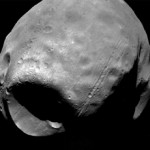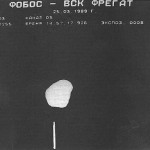Remote Viewing an Anomaly Photographed by the Phobos 2 Spacecraft

The Cue: Describe the most important aspects of the target event at the instant of original imaging by the Phobos 2 spacecraft.
Monitor: Jerry Harthcock
I was blind to the target and the cue. The monitor (Jerry) was semi-frontloaded: He chose the target and created the cue.
In July 1988, Russia launched two unmanned probes—Phobos 1 and Phobos 2—to study Mars and its moons, Phobos and Deimos. Fourteen additional nations participated in the mission, including the United States, Sweden, West Germany and France.

Phobos 1 suffered a critical software failure and was lost before reaching Mars. Phobos 2 successfully entered orbit around Mars and sent back a total of 37 images before communication with the probe was lost on March 27, 1989.
Several of the photos taken by Phobos 2 show strange anomalies on both Mars and its moon Phobos. The final photo shows what appears to be a very large cylindrical object moving towards the small moon.
In this session, I was tasked to describe the most important aspects of the target event captured by Phobos 2 in the last photo taken by the probe before its systems failed.

Because of the unusual nature of this target, I found it difficult to write this article as some of the information is very strange. At this time, I cannot verify most of the perceptions that came through. However, several of my drawings resembled the probe and one drawing resembled the Phobos moon itself.
I perceived a colony of organic biological life forms at the site, which were in a type of incubation process. Some of the life forms were flawed and being rejected, while the rest were being pulled back into itself as if filtering out what was not its own. It appeared that the incubation process and growth rate were dependent on climate and fluctuating temperatures. The life forms had a spongy texture, which was moldy and porous.
Post Your Comment on Facebook
Powered by Facebook Comments